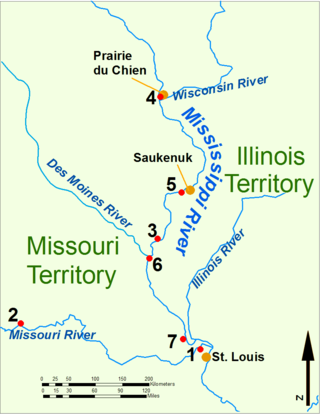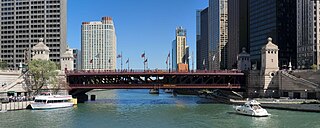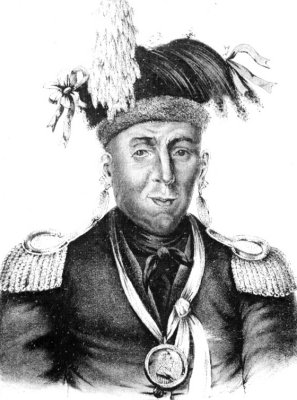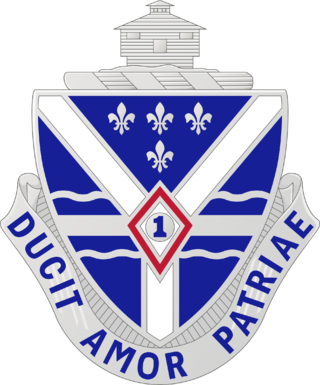See also
- Battle of Fort Dearborn, a battle fought at the Illinois fort between the United States and Potawatomi during the War of 1812.
Fort Dearborn is a historic United States fort in what is now Chicago, Illinois.
Fort Dearborn may also refer to:

The Battle of Fort Dearborn was an engagement between United States troops and Potawatomi Native Americans that occurred on August 15, 1812, near Fort Dearborn in what is now Chicago, Illinois. The battle, which occurred during the War of 1812, followed the evacuation of the fort as ordered by the commander of the United States Army of the Northwest, William Hull. The battle lasted about 15 minutes and resulted in a complete victory for the Native Americans. After the battle, Fort Dearborn was burned down. Some of the soldiers and settlers who had been taken captive were later ransomed.

Fort Dearborn was a United States fort, first built in 1803 beside the Chicago River, in what is now Chicago, Illinois. It was constructed by U.S. troops under Captain John Whistler and named in honor of Henry Dearborn, then United States Secretary of War. The original fort was destroyed following the Battle of Fort Dearborn during the War of 1812, and a replacement Fort Dearborn was constructed on the same site in 1816 and decommissioned by 1837.

Henry Dearborn was an American military officer and politician. In the Revolutionary War, he served under Benedict Arnold in his expedition to Quebec, of which his journal provides an important record. After being captured and exchanged, he served in George Washington's Continental Army. He was present at the British surrender at Yorktown. Dearborn served on General George Washington's staff in Virginia.
The Battle of York was a War of 1812 battle fought in York, Upper Canada on April 27, 1813. An American force, supported by a naval flotilla, landed on the western lakeshore and captured the provincial capital after defeating an outnumbered force of regulars, militia and Ojibwe natives under the command of Major General Roger Hale Sheaffe, the Lieutenant Governor of Upper Canada.
Dearborn may refer to:

The siege of Fort Wayne took place from September 5 – September 12, 1812, during the War of 1812. The stand-off occurred in the modern city of Fort Wayne, Indiana between the U.S. military garrison at Fort Wayne and a combined force of Potawatomi and Miami forces. The conflict began when warriors under the Potawatomi chiefs, Winamac and Five Medals killed two members of the U.S. garrison. Over the next several days, the Potawatomi burned the buildings and crops of the fort's adjacent village, and launched assaults from outside the fort. Winamac withdrew on 12 September, ahead of reinforcements led by Major General William Henry Harrison.

William Wells, also known as Apekonit, was the son-in-law of Chief Little Turtle of the Miami. He fought for the Miami in the Northwest Indian War. During the course of that war, he became a United States Army officer, and also served in the War of 1812.

During the War of 1812, the Illinois Territory was the scene of fighting between Native Americans and United States soldiers and settlers. The Illinois Territory at that time included the areas of modern Illinois, Wisconsin and parts of Minnesota and Michigan.

The DuSable Bridge is a bascule bridge that carries Michigan Avenue across the main stem of the Chicago River in downtown Chicago, Illinois, United States. The bridge was proposed in the early 20th century as part of a plan to link Grant Park (downtown) and Lincoln Park (uptown) with a grand boulevard. Construction of the bridge started in 1918, it opened to traffic in 1920, and decorative work was completed in 1928. The bridge provides passage for vehicles and pedestrians on two levels. An example of a fixed trunnion bascule bridge, it may be raised to allow tall ships and boats to pass underneath. The bridge is included in the Michigan–Wacker Historic District and has been designated as a Chicago Landmark.

Fort Armstrong (1816–1836), was one of a chain of western frontier defenses which the United States erected after the War of 1812. It was located at the foot of Rock Island, in the Mississippi River near the present-day Quad Cities of Illinois and Iowa. It was five miles from the principal Sauk and Meskwaki village on the Rock River in Illinois. Of stone and timber construction, 300 feet square, the fort was begun in May 1816 and completed the following year and consisted of three large blockhouses, like the replica, on its prominent corners. In 1832, the U.S. Army used the fort as a military headquarters during the Black Hawk War. It was normally garrisoned by two companies of United States Army regulars. With the pacification of the Indian threat in Illinois, the U.S. Government ceased operations at Fort Armstrong and the U.S. Army abandoned the frontier fort in 1836.

Waubonsie was a leader of the Potawatomi Native American people. His name has been spelled in a variety of ways, including Wabaunsee, Wah-bahn-se, Waubonsee, Waabaanizii in the contemporary Ojibwe language, and Wabanzi in the contemporary Potawatomi language.

The Prairie Avenue District is a historic district in the Near South Side community area of Chicago, Illinois. It includes the 1800 and 1900 blocks of South Prairie Avenue and the 1800 block of South Indiana, and 211-217 East Cullerton. It was the site of the Battle of Fort Dearborn and became the city's most fashionable residential district after the Great Chicago Fire. It was designated a Chicago Landmark on December 27, 1979. The district was added to the National Register of Historic Places on November 15, 1972. The John J. Glessner House, designed and built by Henry Hobson Richardson in 1885–1886 at 1800 S. Prairie Avenue, has been restored as a historic house museum, and is open for public tours. In 2006, the Prairie District Neighborhood Alliance, a non-profit organization was formed to provide representation for thousands of South Loop residents, including the Prairie Avenue District, Central Station, Museum Park, Motor Row, and the South Michigan Avenue Corridor, as well as other areas of the Near South Side.

Fort Shelby was a military fort in Detroit, Michigan that played a significant role in the War of 1812 (1812-1815). It was built by the |British Army]] in 1779 as Fort Lernoult, and was ceded to the United States by the terms of the Jay Treaty in 1796, following up on the original terms of the peace agreement of the Treaty of Paris that ended the American Revolutionary War (1775-1783), 13 years earlier when the British held on to continuing occupying several fortifications on the new American-Canadian international border. It was renamed Fort Detroit by the U.S. Secretary of War Henry Dearborn in 1805.

Black Partridge or Black Pheasant was a 19th-century Peoria Lake Potawatomi chieftain. Although a participant in the Northwest Indian War and the War of 1812, he was a friend to early American settlers and an advocate for peaceful relations with the United States. He and his brother Waubonsie both attempted to protect settlers during the Battle of Fort Dearborn after they were unsuccessful in preventing the attack.
Wilcox v. Jackson, 38 U.S. 498 (1839), sometimes nicknamed the "Beaubien Land Case" was a legal action decided by the United States Supreme Court concerning the land under Fort Dearborn shortly after incorporation of Chicago as a town in Cook County, Illinois.

The 131st Infantry Regiment is an Infantry Regiment in the Army National Guard.

Ensign George Ronan was a commissioned officer of the United States Army. Educated at West Point and commissioned as an officer in the 1st Infantry Regiment in 1811, he was assigned to duty at Fort Dearborn, a frontier post at the mouth of the Chicago River. Just over one year later Ronan was killed in combat in the Battle of Fort Dearborn. He was the first member of the West Point Corps of Cadets to perish in battle.

The Battle of Wild Cat Creek was the result of a November 1812 punitive expedition against Native American villages during the War of 1812. It has been nicknamed "Spur's Defeat", which is thought to refer to the spurs used by the soldiers to drive their horses away from the battle as quickly as possible. The campaign is sometimes referred to as the Second Battle of Tippecanoe.

Joseph Matthew Martin is a retired general in the United States Army who served as the 37th Vice Chief of Staff of the Army from 2019 to 2022. He previously served as the director of the Army Staff in Washington, D.C.
Big Foot was a leader of the Prairie Band of Potawatomi on Kishwauketoe in what would become the U.S. State of Wisconsin.